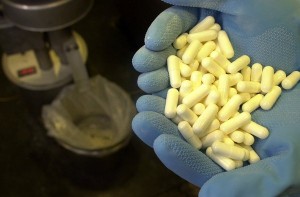Two studies find that an expensive antiretroviral drug campaign in rural KwaZulu-Natal province has reduced risk and extended life expectancy by more than 11 jaar.
An intensive campaign to combat HIV/AIDS with costly antiretroviral drugs in rural Suid-Afrika has increased life expectancy by more than 11 years and significantly reduced the risk of infection for healthy individuals, according to new research.
The two studies, published Thursday in the journal Science, come as wealthy Western nations are debating how best to stretch limited Vigs funding at a time of economic stress.
With an annual price tag of $500 te $900 per patient, antiretroviral therapy programs have stirred frequent debate. Critics argue that adherence to the drug regimen is low and social stigma prevents some from seeking care until they are very ill and have infected others. Cheaper remedies, such as condom distribution, male circumcision and behavior modification, deserve more attention and funding, hulle sê.
The new economic analysis of a $10.8-million campaign in KwaZulu-Natal province concluded that the drug scale-up there had been highly cost-effective.
The program was administered by nurses in rural health clinics in an impoverished region of about 100,000 mense. Treatment consisted primarily of daily doses of antiretroviral therapy, or ART, dwelms, which patients take every day for their entire lives. Patients picked up their medication at a rural clinic once a month.
In 2003, the year before the drugs were available, 29% of all residents were infected with MIV and half of all deaths there were caused by AIDS. Life expectancy in the region was just over 49 jaar.
Deur 2011, life expectancy had grown to 60 1/2 years — “the most rapid life expectancy gains observed in the history of public health,” said study senior author Till Barnighausen, a global health professor at the Harvard School of Public Health.
Based on that increase in longevity, researchers determined just how many years of life were effectively “gained” among residents as a result of ART intervention. They used that figure and the total expense of the program to calculate a cost-effectiveness ratio of $1,593 per life-year saved.
The World Health Organization considers medical intervention to be “highly cost-effective” if the cost per year of life saved is less than a nation’s per capita gross domestic product. The program’s ratio was well below South Africa’s 2011 per capita GDP of about $11,000.
“It’s really a slam dunk of an intervention,” said study leader Jacob Bor, a graduate student at Harvard. “These investments are worthwhile.”
The research team noted that the study period coincided with the arrival of electric power and clean water for area residents. But those alone could not explain the dramatic increase in longevity, Toe sê hulle.
“While mortality due to HIV declined precipitously, mortality due to other causes flat-lined,” Bor said. “These changes were almost certainly due to ART scale-up.”
In a second study from the same region, researchers followed nearly 17,000 healthy people from 2004 te 2011 MIV-infeksie koerse in gebiede met 'n aktiewe ART intervensieprogramme te bepaal.
Gesonde individue in dié gebiede was 38% minder geneig om MIV as die mense in die gebiede waar ART dwelms was nie algemeen beskikbaar te kontrakteer, navorsers gevind. Mense in uiters landelike gebiede ook beter as dié in nouer bevolkte gebiede gegroepeer rondom nasionale paaie gevaar.
Algehele voorkoms van MIV verhoog 6% gedurende die sewe jaar van die studie, waarskynlik omdat die anti-retrovirale middels toegelaat dat mense met die virus om langer te lewe, volgens die verslag.
Dit is nie duidelik hoe die resultate van die nuwe studie sou vertaal na gebiede waar stabiele, saamwoon paartjies was nie die norm, sê hoofskrywer Frank Tanser, 'n epidemioloog aan die Universiteit van KwaZulu-Natal.
AIDS researchers who weren’t involved in the studies said they provide strong support for maintaining programs like the President’s Emergency Plan for AIDS Relief, begun by President George W. Bush in 2003.
“These papers present truly remarkable data,” sê dr. Douglas Richman, director of the Center for AIDS Research at UC San Diego.
Bron: DIE. Keer



No Comments
Antwoorde Anti-MIV-dwelm pogings in Suid-Afrika lewer dramatiese resultate is nou gesluit.